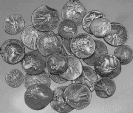
The Qumran Hoard of Silver Coins
24 silver coins. Between 136/135 and 10/9 B.C.E.
Pere Roland de Vaux, a mid twentieth-century excavator of Qumran, relied heavily on coin evidence for his dating and interpretations of the various strata of the site. The early coins in the hoard were minted in Tyre and included tetradrachms of Antiochus VII Sidetes and Demetrius II Nicator (136/135 - 127/126 B.C.E.), as well as six Roman Republican denarii from the mid-first century B.C.E. The bulk of the hoard represents the autonomous continuation of the Seleucid mint: the well-known series of Tyrian shekalim and half-shekalim, minted from 126/125 B.C.E. onward. These are the same coins that were prescribed in the Temple for the poll tax and other payments (Tosefta. Ketubot 13, 20).
Q2;Q3;Q5;Q6;Q8;Q19;Q20;Q21;Q27;Q32;Q65;Q79;Q84;Q87;Q118;Q121;Q122; Q125;Q127;Q131;Q133;Q138;Q143;Q153
Diameter 3/4 - 1 1/8 in.
Courtesy of the Israel Antiquities Authority.
